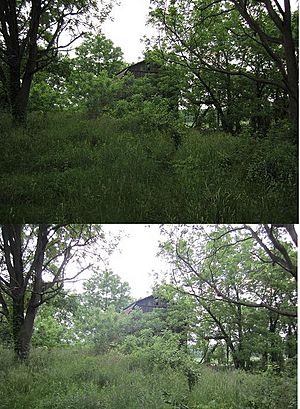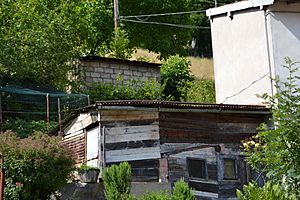Exposure (photography) facts for kids
In photography, exposure is used to mean two things. Photograhic films or sensors have a certain senitivity. That means that a certain amount of light needs to be able to reach the film or sensor, before the image is correctly exposed. An exposure can also refer to a photo exposed that way.
Contents
Underexposure and overexposure
A photograph may be described as overexposed when it has a loss of highlight detail, that is, when important bright parts of an image are "washed out" or effectively all white, known as "blown-out highlights" or "clipped whites". A photograph may be described as underexposed when it has a loss of shadow detail, that is, when important dark areas are "muddy" or indistinguishable from black, known as "blocked-up shadows" (or sometimes "crushed shadows", "crushed blacks", or "clipped blacks", especially in video). As the adjacent image shows, these terms are technical ones. There are three types of settings: manual, automatic and exposure compensation.
Exposure settings
Manual exposure
In manual mode, the photographer adjusts the lens aperture and/or shutter speed to achieve the desired exposure. Many photographers choose to control aperture and shutter independently because opening up the aperture increases exposure, but also decreases the depth of field, and a slower shutter increases exposure but also increases the opportunity for motion blur.
"Manual" exposure calculations may be based on some method of light metering with a working knowledge of exposure values, the APEX system and/or the Zone System.
Automatic exposure
A camera in automatic exposure (abbreviation: AE) mode automatically calculates and adjusts exposure settings to match (as closely as possible) the subject's mid-tone to the mid-tone of the photograph. For most cameras this means using an on-board TTL exposure meter.
Aperture priority mode (commonly abbreviated to Av) gives the photographer manual control of the aperture, whilst the camera automatically adjusts the shutter speed to achieve the exposure specified by the TTL meter. Shutter priority mode (commonly abbreviated to TV) gives manual shutter control, with automatic aperture compensation. In each case, the actual exposure level is still determined by the camera's exposure meter.
Exposure compensation
The purpose of an exposure meter is to estimate the subject's mid-tone luminance and indicate the camera exposure settings required to record this as a mid-tone. In order to do this it has to make a number of assumptions which, under certain circumstances, will be wrong. If the exposure setting indicated by an exposure meter is taken as the "reference" exposure, the photographer may wish to deliberately overexpose or underexpose in order to compensate for known or anticipated metering inaccuracies.
Cameras with any kind of internal exposure meter usually feature an exposure compensation setting which is intended to allow the photographer to simply offset the exposure level from the internal meter's estimate of appropriate exposure. Frequently calibrated in stops, also known as EV units, a "+1" exposure compensation setting indicates one stop more (twice as much) exposure and "–1" means one stop less (half as much) exposure.
Exposure compensation is particularly useful in combination with auto-exposure mode, as it allows the photographer to bias the exposure level without resorting to full manual exposure and losing the flexibility of auto exposure. On low-end video camcorders, exposure compensation may be the only manual exposure control available.
Images for kids
-
A long exposure showing star trails around the south and north celestial poles, viewed from Paranal Observatory. (Credit: ESO)
-
A photograph of the sea after sunset with an exposure time of 15 seconds. The swell from the waves appears foggy.
-
A 1/30 s exposure showing motion blur on fountain at Royal Botanic Gardens, Kew
-
A 1/320 s exposure showing individual drops on fountain at Royal Botanic Gardens, Kew
See also
 In Spanish: Exposición (fotografía) para niños
In Spanish: Exposición (fotografía) para niños













